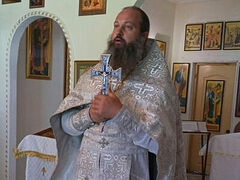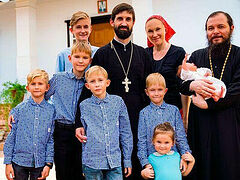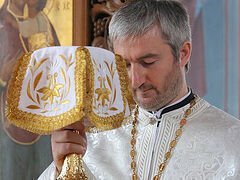Part 1
 Fr. Gregorio and his family in the Mission area
Fr. Gregorio and his family in the Mission area
—How did you decide to become an Orthodox priest?
—My wife and I have always taken faith and the Church very seriously. For thirty years I served as a pastor in a Pentecostal community, eighteen of which as an ordained minister—the highest level of ministerial classification in the Assemblies of God.
When I converted to Orthodoxy, I came to love the Church even more, and after a time I told the rector of our parish that I wanted to become a priest. But I didn’t know the ordination process. I thought I just needed to prepare documents confirming my experience as a pastor.
He asked me to come to the seminary next Saturday for a talk. My rector arranged for me to meet with the ruling hierarch of the Carpatho-Russian Diocese in America, Metropolitan Nicholas, in Johnstown, Pennsylvania. I brought all the documents to the metropolitan and believed that he would probably ordain me the next month. I was wrong.
I was sitting in front of the metropolitan. I didn’t call him “Vladyka” or “Your Eminence”, because I was quite a novice. So I said that I wanted to become a priest and serve the Church.
“Listen,” he said to me. “Do you see this priest?” And he pointed to Fr. Luke.
“Yes, I do,” I answered.
“You will be attached to his parish. Do whatever he tells you. Forget about the priesthood for now.”
I was upset and dispirited.
“All right,” I said. “I will learn under Fr. Luke’s guidance.”
It took me ten years to become a priest. I had to enroll in a special course for laymen, which had been set up by Metropolitan Nicholas. A wonderful course attended by people of different professions: engineers, lawyers, doctors, teachers who were going to serve in the Church.
Initially, the course opened to train deacons, and those who later wanted to become priests had to go to the seminary in Johnstown and take an additional course there. I attended this course for two years, and then the metropolitan ordained me.
Before my ordination I told him, “Vladyka, I want to warn you that if you ordain me, my heart will stay in my native country, and when I retire from my secular work, I will return to Puerto Rico. If you want to keep me in the United States, don’t ordain me.”
“I will ordain you anyway,” Metropolitan Nicholas replied. “Don’t worry.”
I was ordained on September 17, 2006 in Danbury.
Fr. Luke was the rector, and I was his right–hand man at the parish. I was also appointed a “relief priest”, and when one or another priest was on vacation, I temporary served in his church.
When I was fifty-five, I retired after working as a schoolteacher for twenty years, and I intended to spend the rest of my life in Puerto Rico to bring Orthodoxy to my people.
Meanwhile, I met the First Hierarch of the ROCOR, Metropolitan Hilarion (Kapral; †2022) for the first time. He was engaged in missionary activities, opening ROCOR missions worldwide. He received a call from my son, Fr. Silouan, who was sure that Metropolitan Hilarion would help and send me on a mission to Puerto Rico.
I came to the Synodal Headquarters in New York together with my two sons, who were present at our meeting with the metropolitan. Vladyka said that he understood me perfectly and blessed me to create a Mission. Metropolitan Nicholas also supported me and gave me a letter of release.
We sold our house, and I went to Vladyka Hilarion to get antimensions and myrrh. At first Vladyka said that he could not find antimensions. Then he checked again, came back with a smile and said: “Here is the last one signed by Metropolitan Laurus.” That’s how I got antimensions for our Puerto Rican Mission. I asked the metropolitan to give me two years to build the Mission building.
 Fr. Gregorio with his family after the Liturgy on the feast of the Holy Trinity
Fr. Gregorio with his family after the Liturgy on the feast of the Holy Trinity
We came to Puerto Rico and started creating a Mission from scratch. We had only two icons that had been presented to us by priests in the USA. We purchased land and started repairing the house on it to live there and set up a chapel inside.
Soon people began to come to us asking me to baptize them, so we had to start our Mission before the chapel was ready. We celebrated the first Liturgy in 2009, and since then we have celebrated the Liturgy every Sunday.
We baptized forty-two people in San German and prepared fifty more people for Baptism. Unfortunately, in 2017 the city was affected by Hurricane Maria, and we lost several families of our parishioners who moved to the United States. After the hurricane there was an earthquake in the south of the island, the epicenter of which was very close to San German. People were killed, houses were damaged, some of our parishioners suffered as well and left. Then the COVID-19 epidemic broke out. We had the same restrictions here as in the USA, but we decided not to close the parish. My wife and I, along with several other parishioners, celebrated the Liturgy every Sunday, maintaining the life of our Mission.
After COVID was over, many young and well-educated people began to come to us and asked me to baptize them.
—Please tell us about your parishioners.
—The mission is situated in the southwest—in San German, but we have parishioners who travel to the church even from the farthest—the northeastern part of the island. The members of our parish are mostly young people, students who study at universities and work simultaneously. We are happy that we have such a close-knit group of young people, and we pray that they will love the Church and devote part of their lives to the parish. I also hope and pray that someday they and their Orthodox spouses will marry in church. We also have more mature parishioners who are in their fifties, and some are older.
We are making every effort to build a real, large church, because the current chapel is already too small for the parish, especially when a many people gather for services at the great feasts.
I believe I have the best parish a priest can have. We all struggle with certain sins and shortcomings, but my parishioners are serious and strive to learn better what the Orthodox Church can offer them in order to reform.
We have four catechumens in our parish, and they are ready to be baptized. Four more come to the services and classes that we hold on Sundays after the Liturgy and the meal, because they want to learn more about the faith.
—What difficulties does your Mission face?
—The major problem in Puerto Rico is a high unemployment rate, and many young people have to move to the United States. Thus we are losing our young parishioners. But at the same time, the island is becoming a real paradise for tourists who often look for a place to pray during their holidays.
Another problem: When we tell people about Orthodoxy, we show them pictures of beautiful Orthodox churches, but when people come to the Mission, they see only the chapel.
One more problem. We have beautiful, well-educated young ladies, but there are few young men for them to marry. So they pray and... wait for a miracle.
 Fr. Gregorio with his wife Edna (Euphemia). Fifty years together. 2020
Fr. Gregorio with his wife Edna (Euphemia). Fifty years together. 2020
—What character traits do you think a missionary should have?
—First, spiritual qualities are absolutely necessary for a priest, and the most important thing is a great love for the people he serves.
Second, a missionary must have great patience. A mission means endless work. I’m going to serve here as long as God wills, and now I pray for a younger priest for our Mission, for the next leader who will come after me because I’m getting old.
—You have three sons…
—But missionary work is something I cannot impose on them.
—Father Daniel was recently ordained a hierodeacon. How did you feel at his ordination?
—Do you know how long it takes an artist to create a work of art? Sometimes it takes years! When Fr. Daniel was ordained a hierodeacon at the Liturgy, I realized that this ordination was not for me, but for God.
I am a father who wants to do everything possible for his sons. I respect him very much because I know his heart. And all I can do now is pray and thank God. At the altar Fr. Daniel told me that he was afraid that he would start crying in front of people looking at him. But when I went up to him to congratulate him, he was crying like a child, and his whole face was in tears. I kissed him. It is very difficult to put into words what God is doing with my children. This is the reality of the presence of the Holy Spirit in the Church, shaping my children.
—Did he stay in the USA after his ordination?
—Yes, he has been a monk for seventeen years. He came from a monastery in Puerto Rico to help me. Now he struggles at a skete in Atlanta, Georgia, where there is an abbot.
—Your youngest son, Fr. Seraphim, serves in your mission...
—Yes, another person with a kind heart. But he almost became a monk too! He helped me in the Mission and once said that he did not see an Orthodox lady whom he would like to marry. I told him to pray and wait for a miracle. And a miracle happened.
 Fr. Gregorio and Fr. Daniel at the skete in Atlanta
Fr. Gregorio and Fr. Daniel at the skete in Atlanta
I once baptized a woman and her younger daughter. But she did not tell me that she also had an elder daughter. On Sunday she brought her elder daughter—a real beauty! I was leaving the chapel while my son was coming down from the second story of the house and heading to the chapel. The girl was entering the hallway of the house, and the three of us met. I saw her, looked at my son, and my son looked at me, and then at her.
When the service was over, I asked him if he had taken her phone number. So their friendship began, and soon they got married. Now they have three amazing children. The eldest, Lazar, helps me at the altar. The middle one is their daughter Emilia. The youngest was named Luke in honor of St. Luke of Simferopol, an archbishop and a surgeon. I call him the “little bishop” because his face and character resemble those of a bishop. And we have just heard that they’re expecting a fourth baby.
—Father Gregorio, your Mission is dedicated to St. John Climacus. Why did you choose him as the mission’s Heavenly patron?
—I have always had a desire to bring Orthodoxy to Puerto Rico. But I wanted to organize something that is more than just a parish. There are so many preachers here in Puerto Rico! Every Sunday morning you hear on the radio talks by numerous pastors. But monks have never been seen on the island. I am the only priest in my town, but I am not a monk. And St. John Climacus is a monastic saint and our patron, and we pray to him that a skete will be built on the basis of our parish.
—So this is how you see the future of the Mission!
—Now my son, Fr. Daniel, struggles at the Skete in honor of the holy Optina Elders in Atlanta. The monastery was built on the basis of a parish, and this is a brilliant example of the coexistence of a parish and a monastery. This is what we want to do in Puerto Rico in the future. The rector, Archimandrite John (Townsend), agreed to help us, and our future monks will be trained at their skete. I know that it will take years before something like this will be founded on the basis of our Mission. In any case, this is what I would like to see before I die.
 Metropolitan Nicholas of Eastern America and New York with the Kursk-Root Icon in Puerto Rico. August 2021
Metropolitan Nicholas of Eastern America and New York with the Kursk-Root Icon in Puerto Rico. August 2021
We have five acres of land. In August 2021, Metropolitan Nicholas of Eastern America and New York (then Bishop of Manhattan) visited our Mission and blessed a plot of land on which we plan to build a church. But in order to start the construction of a church we have to submit a pile of documents to the Department of Culture. San German is the second town in Puerto Rico after our capital San Juan, and everyone who is going to build something here must submit archeological research and a large report.
Our church will be very beautiful, as in the Holy Trinity Monastery in Jordanville, New York. When we started thinking about a church, we hired an architect, and she showed us her church sketches. But they were all too modern and cold, and we wanted something old in style and warm.
Then the architect advised us to go to Jordanville and see the church there. I called Metropolitan Hilarion and asked for his blessing. He gave me the phone number of Bishop Luke (Murianka) of Syracuse, who is the abbot of the monastery. And Fr. Daniel and I travelled to Jordanville.
Fr. Daniel took photos and gave the architect all the information. It is planned that the church will accommodate up to 100 people.
As of today, the construction documents, since they meet all the requirements, have been approved by the Institute of Culture of Puerto Rico. Now we are waiting for a letter from the Department of Natural and Environmental Resources to move on to the next step: We will inform the neighbors about our construction project. If no one objects, we will be given a construction permit. According to our engineer, if everything goes according to the plan, we will be able to start construction by the end of the year. We have plenty of work to do, and we hope that the Lord will help us in the upcoming labors.
The Orthodox mission in Puerto Rico needs all the liturgical books necessary for the celebration of services in a full-fledged parish community, translated into Spanish, along with Spanish translations of the Patristic writings. We ask those who know where to find the source material to send it or contact the Mission; as well as those who are willing to offer their help as translators, to contact Fr. Gregorio Justiniano via email: curagregorio@gmail.com .








